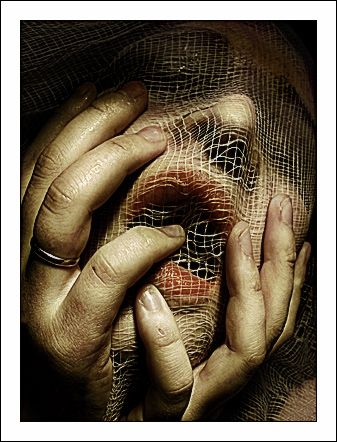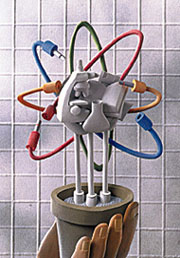I just bought a CanoScan N670U, sold here in Brazil under the Elgin label. This scanner is already discontinued, but is equivalent to the LiDE 20. I downloaded and installed the latest Mac OS X drivers, and brought my iBook to the store for testing – they’d never seen a Mac before.
Installation is very confusing. There are two applications to be downloaded: “CanoScan_N670U_v7010X.app.sit” and “CanoScanToolbox4110X.app.sit”. They have to be unstuffed after downloading. When you run them, they install 4 items on your desktop: two folders (“CanoScan_N670U_v7010X” and “CanoScanToolbox4110X”) and three aliases (“Deldrv.dmg”, “CanoScan Toolbox Installer” and “ScanGear CS Installer”). All aliases point deep into the folders. You’re supposed to run first the “CanoScan Toolbox Installer” and then the “ScanGear CS Installer”; naturally, I ran them in reverse order and it didn’t work correctly at first. One installs the CanoScan Toolbox application, which is run if you press any of the scanner’s buttons; the other one installs the ScanGear CS plug-in into both the CanoScan plug-in folder and, if you have them installed, Adobe PhotoShop/ImageReady plug-in folders.
The whole installation process is very Windows-like; you need to run 4 separate programs in a certain order, and a mess of aliases and folders is left on your desktop. And it’s not as if they never heard of disk images, as they include the “Deldrv.dmg” image which contains a deinstaller program. The installers also tell you to restart (but not why).
Anyway, after the initial unpleasantness, the scanner works quite well, if somewhat slowly, and with a high-pitched whine reminiscent of a wind-up toy. Running the “calibrate” option the first time (and every couple of weeks) is necessary, otherwise you’ll get unsightly streaks on the images. On the positive side, it needs no extra power supply, has a stand to hold it vertically, and is thin and light enough to be easiliy transported with a laptop. And it comes with a USB cable.
The CanoScan Toolbox application is a Carbon port of a Windows application; it has a non-standard window and non-standard buttons, close boxes and so forth. It saves scans, by default, inside the application’s folder which is a definite no-no. You can set the 3 scanner buttons to call one of several functions: two different scan settings, copy (scan and print), e-mail, OCR, save (in a dated folder), or file (just save). The names are somewhat confusing, and the two scan options ask you to select an application to assign the scanned file’s type/creator code. Unfortunately it knows nothing about application bundles, and so you need to drill deep down into the bundle to point at the actual executable, something non-technical users will have difficulties with. You also can’t set two buttons to do the same function, or set a button to do nothing, which was my first impulse. In all, this application is like the installation process itself (and like many Windows apps): overly helpful in some aspects, confusing in others. The included documentation just glosses over these issues.
The PhotoShop/ImageReady plug-in is of better quality, with both a “simple” and “advanced” mode. Some of the advanced preferences are obscurely named, and the tooltips usually just repeat the preference’s name instead of explaining what it really does. After some tests I decided to turn most automatic stuff like cropping and rotating off, and doing my own descreening and sharpening.
All in all, I found the scanner to be quite adequate for my intentions: low-volume scanning for semi-professional use. Non-technical users are advised to try it out first and compare it with other models or brands, or enlist someone knowledgeable to install and configure it.


 .
.


